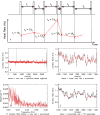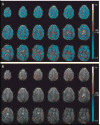Low-frequency fluctuations in the cardiac rate as a source of variance in the resting-state fMRI BOLD signal
- PMID: 17869543
- PMCID: PMC2128785
- DOI: 10.1016/j.neuroimage.2007.07.037
Low-frequency fluctuations in the cardiac rate as a source of variance in the resting-state fMRI BOLD signal
Abstract
Heart rate fluctuations occur in the low-frequency range (<0.1 Hz) probed in functional magnetic resonance imaging (fMRI) studies of resting-state functional connectivity and most fMRI block paradigms and may be related to low-frequency blood-oxygenation-level-dependent (BOLD) signal fluctuations. To investigate this hypothesis, temporal correlations between cardiac rate and resting-state fMRI signal timecourses were assessed at 3 T. Resting-state BOLD fMRI and accompanying physiological data were acquired and analyzed using cross-correlation and regression. Time-shifted cardiac rate timecourses were included as regressors in addition to established physiological regressors (RETROICOR (Glover, G.H., Li, T.Q., Ress, D., 2000. Image-based method for retrospective correction of physiological motion effects in fMRI: RETROICOR. Magn Reson Med 44, 162-167) and respiration volume per unit time (Birn, R.M., Diamond, J.B., Smith, M.A., Bandettini, P.A., 2006b. Separating respiratory-variation-related fluctuations from neuronal-activity-related fluctuations in fMRI. NeuroImage 31, 1536-1548). Significant correlations between the cardiac rate and BOLD signal timecourses were revealed, particularly negative correlations in gray matter at time shifts of 6-12 s and positive correlations at time shifts of 30-42 s (TR=6 s). Regressors consisting of cardiac rate timecourses shifted by delays of between 0 and 24 s explained an additional 1% of the BOLD signal variance on average over the whole brain across 9 subjects, a similar additional variance to that explained by respiration volume per unit time and RETROICOR regressors, even when used in combination with these other physiological regressors. This suggests that including such time-shifted cardiac rate regressors will be beneficial for explaining physiological noise variance and will thereby improve the statistical power in future task-based and resting-state fMRI studies.
Figures









Similar articles
-
Correlated slow fluctuations in respiration, EEG, and BOLD fMRI.Neuroimage. 2013 Oct 1;79:81-93. doi: 10.1016/j.neuroimage.2013.04.068. Epub 2013 Apr 28. Neuroimage. 2013. PMID: 23631982
-
Physiological denoising of BOLD fMRI data using Regressor Interpolation at Progressive Time Delays (RIPTiDe) processing of concurrent fMRI and near-infrared spectroscopy (NIRS).Neuroimage. 2012 Apr 15;60(3):1913-23. doi: 10.1016/j.neuroimage.2012.01.140. Epub 2012 Feb 9. Neuroimage. 2012. PMID: 22342801 Free PMC article.
-
Effects of model-based physiological noise correction on default mode network anti-correlations and correlations.Neuroimage. 2009 Oct 1;47(4):1448-59. doi: 10.1016/j.neuroimage.2009.05.012. Epub 2009 May 14. Neuroimage. 2009. PMID: 19446646 Free PMC article.
-
Spontaneous low-frequency blood oxygenation level-dependent fluctuations and functional connectivity analysis of the 'resting' brain.Magn Reson Imaging. 2008 Sep;26(7):1055-64. doi: 10.1016/j.mri.2008.05.008. Epub 2008 Jul 26. Magn Reson Imaging. 2008. PMID: 18657923 Review.
-
[Functional connectivity analysis of the brain network using resting-state FMRI].Brain Nerve. 2011 Dec;63(12):1307-18. Brain Nerve. 2011. PMID: 22147450 Review. Japanese.
Cited by
-
Dynamic brain-body coupling of breath-by-breath O2-CO2 exchange ratio with resting state cerebral hemodynamic fluctuations.PLoS One. 2020 Sep 21;15(9):e0238946. doi: 10.1371/journal.pone.0238946. eCollection 2020. PLoS One. 2020. PMID: 32956397 Free PMC article.
-
Dynamic reconfiguration of the default mode network during narrative comprehension.Nat Commun. 2016 Jul 18;7:12141. doi: 10.1038/ncomms12141. Nat Commun. 2016. PMID: 27424918 Free PMC article.
-
The Sensory and Motor Components of the Cortical Hierarchy Are Coupled to the Rhythm of the Stomach during Rest.J Neurosci. 2022 Mar 16;42(11):2205-2220. doi: 10.1523/JNEUROSCI.1285-21.2021. Epub 2022 Jan 24. J Neurosci. 2022. PMID: 35074866 Free PMC article.
-
EEG-Informed fMRI: A Review of Data Analysis Methods.Front Hum Neurosci. 2018 Feb 6;12:29. doi: 10.3389/fnhum.2018.00029. eCollection 2018. Front Hum Neurosci. 2018. PMID: 29467634 Free PMC article. Review.
-
Inferring multi-scale neural mechanisms with brain network modelling.Elife. 2018 Jan 8;7:e28927. doi: 10.7554/eLife.28927. Elife. 2018. PMID: 29308767 Free PMC article.
References
-
- Akselrod S, Gordon D, Ubel FA, Shannon DC, Berger AC, Cohen RJ. Power spectrum analysis of heart rate fluctuation: a quantitative probe of beat-to-beat cardiovascular control. Science. 1981;213:220–222. - PubMed
-
- Bhattacharyya PK, Lowe MJ. Cardiac-induced physiologic noise in tissue is a direct observation of cardiac-induced fluctuations. Magn Reson Imaging. 2004;22:9–13. - PubMed
-
- Birn R, Murphy K, Bandettini P, Bodurka J. The use of multiple physiologic parameter regression increases gray matter temporal signal to noise by up to 50%. Proceedings 13th Scientific Meeting, International Society for Magnetic Resonance in Medicine; Seattle. 2006a. p. 1091.
-
- Birn RM, Diamond JB, Smith MA, Bandettini PA. Separating respiratory-variation-related fluctuations from neuronal-activity-related fluctuations in fMRI. Neuroimage. 2006b;31:1536–1548. - PubMed
-
- Biswal B, Yetkin FZ, Haughton VM, Hyde JS. Functional connectivity in the motor cortex of resting human brain using echo-planar MRI. Magn Reson Med. 1995;34:537–541. - PubMed
Publication types
MeSH terms
Grants and funding
LinkOut - more resources
Full Text Sources
Other Literature Sources
Medical

